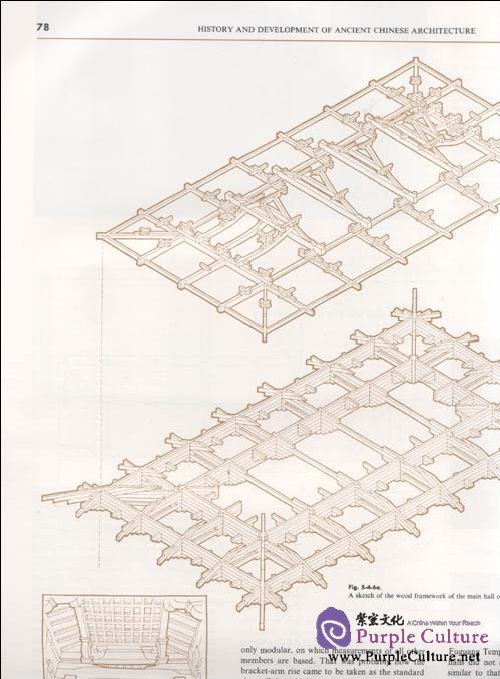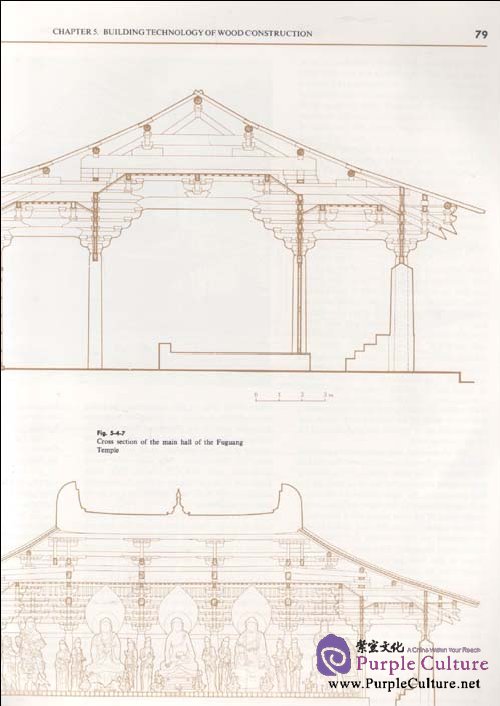Sample Pages Preview


According to the inscription on the stone stele erected inside the temple in the 16th year of the Dading reign of the Jin Dynasty (1176), this architectural complex was constructed 800 years ago, during the Jin Dynasty, and most of what we see today was rebuilt in the Ming and Qing Dynasties.
As shown by its layout, a flight of stone steps was first built along the north side of the mountain, leading to the cliff, where the construction of the main buildings of the temple commenced, moving higher and higher up the cliff as it spread southward.
Stringed together by a gallery projecting from the cliff, these buildings formed an integrated architectural complex, so high up in the air that they seem to be buildings in a faryland.
There is no groundwork to carry the temple; instead, beams projecting from the cliff were made to support the full load of the houses and galleries. In order to guarantee safety, the projecting beams were in turn supported by struts underneath, wherever necessary craftsmen secured the projecting beams and struts into the cliff by chiselling holes it, and then inserting the beams and struts into the holes. The loose beams were then made fast by wedges. With
wood boards laid on these projecting beams and beam framework erected over, the suspended temple, together with its galleries, all eventually emerged in view.
Bold inventions and creations were introduced both in the design and the construction of the temple. No written record has been found so far which may help to reveal how it was first built, but a lot of records are available about its rebuilding. According to the inscription on a stone stele, when the rebuilding of the temple was under contemplation in the 3rd year of Tongzhi reign of the Qing Dynasty, everyone was at a loss to know how to go about the task, because the temple was too high up for any scaffold to reach. It was then that a carpenter named Zhang Tingyan made a brave proposal for replacing the projecting beams without setting up a scaffold. Zhang and his workmates lowered themselves down the cliff by tying one end of a rope around their waists and fastening the other end to the top of the cliff. Thus they were able to move freely in all directions while working in mid air, and in less than a year's time the rebuilding was completed. From this one can perhaps venture a conjecture that the same measure had been taken when the temple was first constructed
Preface
Architecture is an important part of the culture created by a nation. As a certain type of architecture mirrors, in a comprehensive way, the scientific, technological, cultural and artistic level of a nation attained at a given time in history, the study of the development of architecture is bound to be an important aspect of the history of science and culture of the nation.
China is one of the oldest countries in the world. By their joint efforts, the labouring people, scholars and craftsmen of ancient China created a splendid national culture and bequeathed to posterity a rich architectural heritage. The imposing Great Wall, the Imperial Palace, the graceful gardens, the towering ancient pagodas and the domestic houses scattered throughout China have long won the admiration of the people the world over.
The exploration by Chinese scholars of the history of ancient Chinese architecture started long ago. The efforts made in the thirties were particularly significant, when the large amount of inquiry done laid a solid foundation for the research into ancient Chinese architecture. After the founding of New China, work in this respect has seen further developments.
A construction is usually a combination of manpower and social wealth with science and technology. Without this combination, any piece of architecture would be impossible. That is why the exploration of the history of architecture entails a study of the subject from different angles——from the angle of material production, of social economy, and of science and technology. Otherwise, it will be impossible to discover the laws governing the historical development of architecture, nor can an objective appraisal be made of any given construction.
Unfortunately, these concerns are what past studies have overlooked.
For a long time, it has been our wish to compile a book devoted to the study of the building technology of ancient China, which, by sorting out and summing up the technological achievements scored in this field, would help deepen our study and bring about a comprehensive understanding of ancient Chinese architecture.

